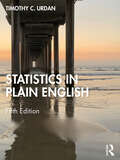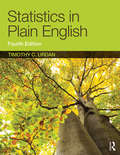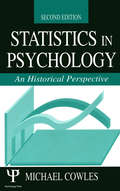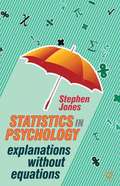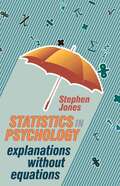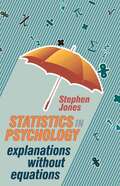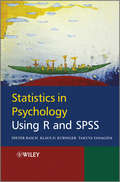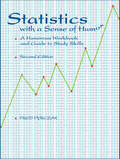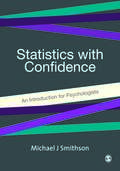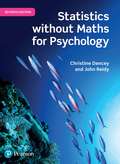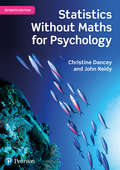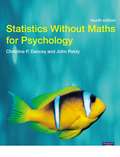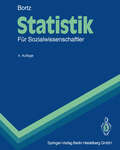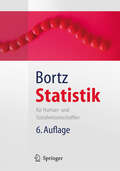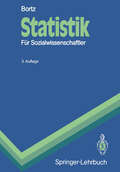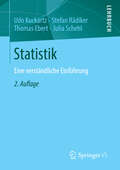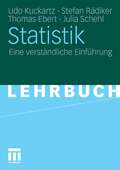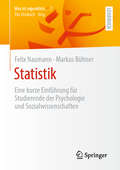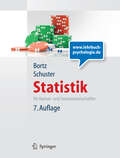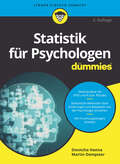- Table View
- List View
Statistics in Plain English
by Timothy C. UrdanStatistics in Plain English is a straightforward, conversational introduction to statistics that delivers exactly what its title promises. Each chapter begins with a brief overview of a statistic (or set of statistics) that describes what the statistic does and when to use it, followed by a detailed step-by-step explanation of how the statistic works and exactly what information it provides. Chapters also include an example of the statistic (or statistics) used in real-world research, "Worked Examples," "Writing It Up" sections that demonstrate how to write about each statistic, "Wrapping Up and Looking Forward" sections, and practice work problems. Thoroughly updated throughout, this edition features several key additions and changes. First, a new chapter on person-centered analyses, including cluster analysis and latent class analysis (LCA) has been added, providing an important alternative to the more commonly used variable-centered analyses (e.g., t tests, ANOVA, regression). Next, the chapter on non-parametric statistics has been enhanced with in-depth descriptions of Mann-Whitney U, Kruskal-Wallis, and Wilcoxon Signed-Rank analyses, in addition to the detailed discussion of the Chi-square statistic found in the previous edition. These nonparametric statistics are widely used when dealing with nonnormally distributed data. This edition also includes more information about the assumptions of various statistics, including a detailed explanation of the assumptions and consequences of violating the assumptions of regression, as well as more coverage of the normal distribution in statistics. Finally, the book features a multitude of real-world examples throughout to aid student understanding and provides them with a solid understanding of how several statistics techniques commonly used by researchers in the social sciences work. Statistics in Plain English is suitable for a wide range of readers, including students taking their first statistics course, professionals who want to refresh their statistical memory, and undergraduate or graduate students who need a concise companion to a more complicated text used in their class. The text works as a standalone or as a supplement and covers a range of statistical concepts from descriptive statistics to factor analysis and person-centered analyses.
Statistics in Plain English, Fourth Edition
by Timothy C. UrdanThis introductory textbook provides an inexpensive, brief overview of statistics to help readers gain a better understanding of how statistics work and how to interpret them correctly. Each chapter describes a different statistical technique, ranging from basic concepts like central tendency and describing distributions to more advanced concepts such as t tests, regression, repeated measures ANOVA, and factor analysis. Each chapter begins with a short description of the statistic and when it should be used. This is followed by a more in-depth explanation of how the statistic works. Finally, each chapter ends with an example of the statistic in use, and a sample of how the results of analyses using the statistic might be written up for publication. A glossary of statistical terms and symbols is also included. Using the author’s own data and examples from published research and the popular media, the book is a straightforward and accessible guide to statistics. New features in the fourth edition include: sets of work problems in each chapter with detailed solutions and additional problems online to help students test their understanding of the material, new "Worked Examples" to walk students through how to calculate and interpret the statistics featured in each chapter, new examples from the author’s own data and from published research and the popular media to help students see how statistics are applied and written about in professional publications, many more examples, tables, and charts to help students visualize key concepts, clarify concepts, and demonstrate how the statistics are used in the real world. a more logical flow, with correlation directly preceding regression, and a combined glossary appearing at the end of the book, a Quick Guide to Statistics, Formulas, and Degrees of Freedom at the start of the book, plainly outlining each statistic and when students should use them, greater emphasis on (and description of) effect size and confidence interval reporting, reflecting their growing importance in research across the social science disciplines an expanded website at www.routledge.com/cw/urdan with PowerPoint presentations, chapter summaries, a new test bank, interactive problems and detailed solutions to the text’s work problems, SPSS datasets for practice, links to useful tools and resources, and videos showing how to calculate statistics, how to calculate and interpret the appendices, and how to understand some of the more confusing tables of output produced by SPSS. Statistics in Plain English, Fourth Edition is an ideal guide for statistics, research methods, and/or for courses that use statistics taught at the undergraduate or graduate level, or as a reference tool for anyone interested in refreshing their memory about key statistical concepts. The research examples are from psychology, education, and other social and behavioral sciences.
Statistics in Plain English, Fourth Edition
by Timothy C. UrdanThis introductory textbook provides an inexpensive, brief overview of statistics to help readers gain a better understanding of how statistics work and how to interpret them correctly. Each chapter describes a different statistical technique, ranging from basic concepts like central tendency and describing distributions to more advanced concepts such as t tests, regression, repeated measures ANOVA, and factor analysis. Each chapter begins with a short description of the statistic and when it should be used. This is followed by a more in-depth explanation of how the statistic works. Finally, each chapter ends with an example of the statistic in use, and a sample of how the results of analyses using the statistic might be written up for publication. A glossary of statistical terms and symbols is also included. Using the author’s own data and examples from published research and the popular media, the book is a straightforward and accessible guide to statistics. New features in the fourth edition include: sets of work problems in each chapter with detailed solutions and additional problems online to help students test their understanding of the material, new "Worked Examples" to walk students through how to calculate and interpret the statistics featured in each chapter, new examples from the author’s own data and from published research and the popular media to help students see how statistics are applied and written about in professional publications, many more examples, tables, and charts to help students visualize key concepts, clarify concepts, and demonstrate how the statistics are used in the real world. a more logical flow, with correlation directly preceding regression, and a combined glossary appearing at the end of the book, a Quick Guide to Statistics, Formulas, and Degrees of Freedom at the start of the book, plainly outlining each statistic and when students should use them, greater emphasis on (and description of) effect size and confidence interval reporting, reflecting their growing importance in research across the social science disciplines an expanded website at www.routledge.com/cw/urdan with PowerPoint presentations, chapter summaries, a new test bank, interactive problems and detailed solutions to the text’s work problems, SPSS datasets for practice, links to useful tools and resources, and videos showing how to calculate statistics, how to calculate and interpret the appendices, and how to understand some of the more confusing tables of output produced by SPSS. Statistics in Plain English, Fourth Edition is an ideal guide for statistics, research methods, and/or for courses that use statistics taught at the undergraduate or graduate level, or as a reference tool for anyone interested in refreshing their memory about key statistical concepts. The research examples are from psychology, education, and other social and behavioral sciences.
Statistics in Psychology: An Historical Perspective
by Michael CowlesThis book presents an historical overview of the field--from its development to the present--at an accessible mathematical level. This edition features two new chapters--one on factor analysis and the other on the rise of ANOVA usage in psychological research. Written for psychology, as well as other social science students, this book introduces the major personalities and their roles in the development of the field. It provides insight into the disciplines of statistics and experimental design through the examination of the character of its founders and the nature of their views, which were sometimes personal and ideological, rather than objective and scientific. It motivates further study by illustrating the human component of this field, adding dimension to an area that is typically very technical. Intended for advanced undergraduate and/or graduate students in psychology and other social sciences, this book will also be of interest to instructors and/or researchers interested in the origins of this omnipresent discipline.
Statistics in Psychology: An Historical Perspective
by Michael CowlesThis book presents an historical overview of the field--from its development to the present--at an accessible mathematical level. This edition features two new chapters--one on factor analysis and the other on the rise of ANOVA usage in psychological research. Written for psychology, as well as other social science students, this book introduces the major personalities and their roles in the development of the field. It provides insight into the disciplines of statistics and experimental design through the examination of the character of its founders and the nature of their views, which were sometimes personal and ideological, rather than objective and scientific. It motivates further study by illustrating the human component of this field, adding dimension to an area that is typically very technical. Intended for advanced undergraduate and/or graduate students in psychology and other social sciences, this book will also be of interest to instructors and/or researchers interested in the origins of this omnipresent discipline.
Statistics In Psychology: Explanations Without Equations
by Stephen JonesA refreshing and much-needed introduction to statistics in psychology for students who 'don't get numbers'. Jones breaks from the traditional, numerical approaches, drawing on non-numerical examples and scenarios from both psychological literature and everyday life to explain key statistical concepts. This is an ideal companion to core textbooks.
Statistics in Psychology: Explanations without Equations
by Stephen JonesHow do you choose the appropriate statistical method for any given research task? What are the features that discern one statistical method from another, and for which research projects are they appropriate to use? Written specifically with the undergraduate psychology student in mind and for those who desire an explanation for the use of statistics in psychological research without the mathematics, this refreshing and much-needed introduction is invaluable for any psychology students who ‘don’t get numbers’. Breaking away from the traditional, numerical approaches, Jones delivers an engaging and insightful read into the rationale behind the use of statistics, drawing upon non-numerical examples and scenarios from both psychological literature and everyday life to explain key statistical concepts. Learn about the methods for testing populations and samples, standard errors, inferential and descriptive statistics as well as variables and participants. This is an ideal companion to core textbooks and will serve a clearer understanding of statistical methods in psychology. By reading this book students can hope to gain a better sense of what makes empirically valid research and learn to critically evaluate facts and figure in any presented research. The foundations of psychology’s claims are the empiricism of well-conducted and reliable data.
Statistics in Psychology: Explanations without Equations
by Stephen JonesHow do you choose the appropriate statistical method for any given research task? What are the features that discern one statistical method from another, and for which research projects are they appropriate to use? Written specifically with the undergraduate psychology student in mind and for those who desire an explanation for the use of statistics in psychological research without the mathematics, this refreshing and much-needed introduction is invaluable for any psychology students who 'don't get numbers'. Breaking away from the traditional, numerical approaches, Jones delivers an engaging and insightful read into the rationale behind the use of statistics, drawing upon non-numerical examples and scenarios from both psychological literature and everyday life to explain key statistical concepts. Learn about the methods for testing populations and samples, standard errors, inferential and descriptive statistics as well as variables and participants. This is an ideal companion to core textbooks and will serve a clearer understanding of statistical methods in psychology. By reading this book students can hope to gain a better sense of what makes empirically valid research and learn to critically evaluate facts and figure in any presented research. The foundations of psychology's claims are the empiricism of well-conducted and reliable data.
Statistics in Psychology Using R and SPSS
by Dieter Rasch Klaus Kubinger Takuya YanagidaStatistics in Psychology covers all statistical methods needed in education and research in psychology. This book looks at research questions when planning data sampling, that is to design the intended study and to calculate the sample sizes in advance. In other words, no analysis applies if the minimum size is not determined in order to fulfil certain precision requirements. The book looks at the process of empirical research into the following seven stages: Formulation of the problem Stipulation of the precision requirements Selecting the statistical model for the planning and analysis The (optimal) design of the experiment or survey Performing the experiment or the survey Statistical analysis of the observed results Interpretation of the results.
Statistics in Psychology Using R and SPSS
by Dieter Rasch Klaus Kubinger Takuya YanagidaStatistics in Psychology covers all statistical methods needed in education and research in psychology. This book looks at research questions when planning data sampling, that is to design the intended study and to calculate the sample sizes in advance. In other words, no analysis applies if the minimum size is not determined in order to fulfil certain precision requirements. The book looks at the process of empirical research into the following seven stages: Formulation of the problem Stipulation of the precision requirements Selecting the statistical model for the planning and analysis The (optimal) design of the experiment or survey Performing the experiment or the survey Statistical analysis of the observed results Interpretation of the results.
Statistics with a Sense of Humor: A Humorous Workbook & Guide to Study Skills
by Fred Pyrczak•We’ve added a comprehensive basic math review to this edition. It will get your students off to a good start in statistics. • In the worksheets, students obtain answers to humorous riddles if their work is correct. If the answer to a riddle does not make sense, they know to check their work. • Easy to coordinate with all major statistics textbooks because each exercise covers only a limited number of statistics. • All major topics are included—from calculating percentages to conducting a one-way ANOVA. • Over 40 humorously illustrated, interactive guides give your students solid advice on study skills covering everything from how to get the most out of a statistics textbook to how to work with a tutor. • The 64-page instructor’s answer key shows all the steps in the solutions for the computational problems. This key makes it easy for you to start using the workbook right away. • This book has been a perennial best-seller. Minor adjustments throughout bring you an improved Second Edition for 1999.
Statistics with a Sense of Humor: A Humorous Workbook & Guide to Study Skills
by Fred Pyrczak•We’ve added a comprehensive basic math review to this edition. It will get your students off to a good start in statistics. • In the worksheets, students obtain answers to humorous riddles if their work is correct. If the answer to a riddle does not make sense, they know to check their work. • Easy to coordinate with all major statistics textbooks because each exercise covers only a limited number of statistics. • All major topics are included—from calculating percentages to conducting a one-way ANOVA. • Over 40 humorously illustrated, interactive guides give your students solid advice on study skills covering everything from how to get the most out of a statistics textbook to how to work with a tutor. • The 64-page instructor’s answer key shows all the steps in the solutions for the computational problems. This key makes it easy for you to start using the workbook right away. • This book has been a perennial best-seller. Minor adjustments throughout bring you an improved Second Edition for 1999.
Statistics with Confidence: An Introduction for Psychologists (PDF)
by Professor Michael SmithsonThis textbook offers an accessible and comprehensive introduction to statistics for all undergraduate psychology students, but particularly those in their second and third years who have already covered an initial introductory course. It covers all of the key areas in quantitative methods including sampling, significance tests, regression, and multivariate techniques and incorporates a range of exercises and problems at the end of each chapter for the student to follow. The free CD-ROM with tutorial modules complements and enhances the exercises in the text, offers scope for distance learning, and makes both the traditional and non-traditional approaches much more accessible. Key points of the book are: an emphasis on measurement, data summaries and graphs; a clear explanation of statistical inference using sampling distributions and confidence intervals, making significance tests much easier to understand; and help for students to understand and judge the use of particular tests in the research context beyond simple recipe following.
Statistics Without Maths for Psychology
by John Reidy Prof Christine DanceyHighly praised for its clear, straightforward approach, Statistics without Maths 7th edition provides a comprehensive and accessible introduction to statistics and SPSS. This widely used and trusted textbook is packed with examples, activities and questions to help you to test your learning and deepen your understanding in a practical and manageable way. Statistics without Maths for Psychology, 7e, will help you to gain the confidence to apply statistical concepts and use SPSS to analyse data within your studies and future independent research.
Statistics Without Maths for Psychology
by John Reidy Prof Christine DanceyThis is the enhanced ebook for Dancey and Reidy, Statistics without Maths for Psychology 7eThis enhanced ebook version of Statistics without Maths for Psychology 7e contains a selection of additional interactive features specifically designed to support you in your study, including: Multiple choice questions with dedicated and immediate feedback are embedded at the end of key sections to enable you to check your understanding and manage your progress. Video screencasts provide step by step walk-throughs to show you in detail how to carry out a full range of SPSS procedures.End of chapter quiz with dedicated feedback allows you to check your knowledge of key topics and concepts and help you prepare for exams.Highly praised for its clear, straightforward approach, Statistics without Maths 7th edition provides a comprehensive and accessible introduction to statistics and SPSS. This widely used and trusted textbook is packed with examples, activities and questions to help you to test your learning and deepen your understanding in a practical and manageable way. Statistics without Maths for Psychology, 7e, will help you to gain the confidence to apply statistical concepts and use SPSS to analyse data within your studies and future independent research.
Statistics Without Maths for Psychology (PDF)
by Christine P. Dancey John ReidyStatistics Without Maths for Psychology is an essential companion to any psychology course, guiding students through the process of using statistics without mathematical formulae. It provides the tools to use SPSS and gives clear but comprehensive explanations of all the statistical concepts needed. This text offers students the opportunity to test their knowledge and practice their skills with activities, exercises and multiple choice questions, and is packed with up-to-date examples, “discussion points” and handy tips to aid them in their studies.
Statistik: für Sozialwissenschaftler (Springer-Lehrbuch)
by Jürgen BortzPrüfungsrelevanz und ein optimales didaktisches Konzept zeichnen dieses Standard-Lehrbuch der Statistik aus.Die fünfte Auflage ist komplett überarbeitet und damit jetzt noch studentengerechter.Neu:- Komprimierte Sammlung der wichtigsten Formeln zum schnellen Nachschlagen- Glossar mit den wichtigsten Begriffs-Definitionen kurzgefaßt auf einen Blick- Überarbeitete Lösungen mit Schritt-für-Schritt-Beispielen: durch Mitarbeit von Studenten garantiert verständlich und leicht nachvollziehbar- Neue Gestaltung, noch lesefreundlicher und übersichtlicher Interpretationshilfen, Anleitungen für die Auswertung mit dem PC und Hinweise zur Bestimmung optimaler Stichprobenumfänge garantieren effektives Lernen und Arbeiten.
Statistik: Für Sozialwissenschaftler (Springer-Lehrbuch)
by Jürgen BortzPrüfungsrelevanz und ein durchdachtes didaktisches Konzept zeichnen auch die vierte Auflage des mittlerweile zum Standardwerk gewordenen Lehrbuchs der Statistik aus. Die Neuauflage berücksichtigt neuere Entwicklungen in der Statistik. Auch wurde Wert auf eine Form der Darstellung gelegt, die das Verständnis von Zusammenhängen und Verbindungen in der Statistik fördert. Interpretationshilfen und Hinweise zur Bestimmung optimaler Stichprobenumfänge für die wichtigsten Verfahren, ein strukturierendes Layout, das wichtige Merksätze und Beispiele hervorhebt, und nicht zuletzt Übungsaufgaben, deren Lösungen verständlich und nachvollziehbar gehalten sind - all dies macht den "BORTZ" für Studenten der Sozialwissenschaften wie auch für Anwender zu einem wertvollen und unerläßlichen Lehrbuch.
Statistik: für Human- und Sozialwissenschaftler (Springer-Lehrbuch)
by Jürgen BortzRechnen Sie mit dem Bortz! Auch in der 6. Auflage ist der BORTZ ein wertvolles und unerlässliches Lehrbuch für Studenten der Psychologie, der Sozialwissenschaften und für Anwender. Anschaulich- Beispiele: Vollziehen Sie Berechnungen durch Beispiele einfach nach.- Glossar: Schlagen Sie die wichtigsten Begriffsdefinition schnell nach.- Mit Formelsammlung: So finden Sie zentrale Formeln der Statistik möglichst rasch.- SPSS-Beispiele: So interpretieren Sie die Ergebnisse des Statistikprogramms richtig. Prüfungsrelevant- Im Grundstudium zur Prüfungsvorbereitung unverzichtbar- Alles drin – von Elementarstatistik über varianzanalytische Methoden bis zu multivariaten Methoden- Übungsaufgaben mit einfach nachvollziehbaren Lösungen – unter Mitarbeit von Studenten überarbeitet.- Formeln verstehen statt stures Auswendiglernen Alltagstauglich- Nachschlagewerk im Hauptstudium und in der Forschung- Nachvollziehen von Berechnungen durch Beispiele aus dem psychologischen Forschungsalltag- Interpretationshilfen und Anleitungen für die Auswertung mit dem PC- Hinweise zur Bestimmung optimaler Stichprobenumfänge Der Bortz hat die Prüfung bestanden!
Statistik: Für Sozialwissenschaftler (Springer-Lehrbuch)
by Jürgen BortzDas erfolgreiche Statistik-Lehrbuch liegt jetzt in der 3. Auflage vor. Das Lehrbuch, das sich inzwischen zu einem Standardwerk in den Sozialwissenschaften, der Medizin und der Biologie entwickelt hat, führt auch den mathematisch wenig geschulten Leser an komplizierte Verfahren heran. Dem fortgeschrittenen Studenten eröffnet es die Möglichkeit, den mathematischen Hintergrund einzelner Verfahren zu vertiefen und neue Ansätze kennenzulernen. Aus den Besprechungen der früheren Auflagen: "Das durch seinen didaktischen Aufbau, seine Verständlichkeit sowie durch seine Gliederung in Elementar-Statistik, varianzanalytische Methoden und multivariate Methoden sich auszeichnende Buch eignet sich sowohl als Lehrbuch als auch als Nachschlagewerk... . Bestimmte Kapitel, die dem Anfänger als Erstlektüre empfohlen werden, sind besonders gekennzeichnet." Die Naturwissenschaften#1
Statistik: Eine verständliche Einführung
by Udo Kuckartz Stefan Rädiker Thomas Ebert Julia SchehlDieses Lehrbuch der statistischen Datenanalyse wurde speziell für Einführungskurse konzipiert und richtet sich an alle, die eine leicht verständliche Einführung in die sozialwissenschaftliche Statistik suchen. Es bezieht sich auf das Feld der Erziehungs- und Sozialwissenschaften und behandelt den Stoff nicht als inhaltsunabhängiges mathematisches Wissen.
Statistik: Eine verständliche Einführung
by Udo Kuckartz Stefan Rädiker Thomas Ebert Julia SchehlDieses Lehrbuch der statistischen Datenanalyse wurde speziell für Einführungskurse konzipiert und richtet sich an alle, die eine leicht verständliche Einführung in die sozialwissenschaftliche Statistik suchen. Es bezieht sich auf das Feld der Erziehungs- und Sozialwissenschaften und behandelt den Stoff nicht als inhaltsunabhängiges mathematisches Wissen. Sie lernen: • Die Basismethoden der Deskriptiv- und Inferenzstatistik • Die wichtigsten Techniken der graphischen Darstellung • Die Logik statistischen Argumentierens • Die Grundzüge komplexerer statistischer Verfahren • Outputs von SPSS bzw. SYSTAT richtig zu lesen • Resultate statistischer Analysen zu interpretieren • Ergebnisse von Forschungsprojekten zu verstehen
Statistik: Eine kurze Einführung für Studierende der Psychologie und Sozialwissenschaften (Was ist eigentlich …?)
by Felix Naumann Markus BühnerDieses kleine Lehrbuch aus der Reihe „Was ist eigentlich …?“ gibt eine kurze Einführung in die grundlegenden Methoden der quantitativen Statistik in sozialwissenschaftlichen Fächern. Sie will Studierenden der Psychologie, Sozialwissenschaften oder verwandter Fächer zu Beginn des Studiums bei einer Orientierung in dieser Teildisziplin verhelfen. Sie bietet aber auch für Fachfremde, die an psychologischen Methoden interessiert sind, einen ersten Einblick in die deskriptive Statistik, Inferenzstatistik sowie statistische Modellierung.
Statistik für Human- und Sozialwissenschaftler: Limitierte Sonderausgabe (Springer-Lehrbuch)
by Jürgen Bortz Christof SchusterDas Lehrbuch vermittelt umfassend die Grundlagen und Methoden der Statistik. Es enthält zahlreiche anschauliche Beispiele und Übungsaufgaben, auch aus der psychologischen Forschung, sowie eine Formelsammlung und ein Glossar zum schnellen Rechnen und Nachschlagen. In der 7. Auflage wurden die Grundlagen für Einsteiger noch verständlicher formuliert, der Inhalt mit neuen Didaktikelementen noch klarer strukturiert. Neu ist auch eine Website mit SPSS-Anleitungen zu allen Beispielen, mit Lerntools für Studierende und Lehrmaterialien für Dozenten.
Statistik für Psychologen für Dummies (Für Dummies)
by Donncha Hanna Martin DempsterWer sich mit Psychologie beschäftigen will, muss sich meist auch mit Statistik beschäftigen und das auch noch recht umfassend. Wenn Statistik nicht so Ihr Thema ist, dann ist dies das richtige Buch für Sie. Donncha Hanna und Martin Dempster erklären Ihnen, was Sie über Regression, Korrelation und ANOVA wissen sollten. Sie erfahren, was Sie über Wahrscheinlichkeit, Deduktion und Hypothesentests wissen sollten und vieles mehr. Außerdem erhalten Sie eine kurze Einführung in SPSS sowie R beziehungsweise RStudio und lernen die für Sie wichtigen Funktionen dieser umfangreichen Programme kennen. So ist dieses Buch ein angenehmer Einstieg für alle, die sich nicht wirklich auf Statistik freuen.
